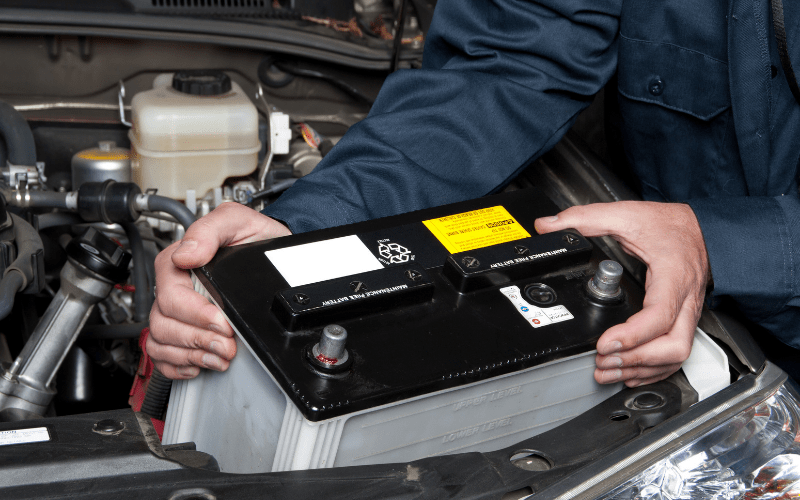Published Date: December 30, 2020
Last Updated on June 22, 2023 by Camper Front
A regular 12-volt car battery usually consists of six cells that chemically produce the voltage and amperage needed to start up your car. When one or more of these battery cells fails, the battery becomes incapable of producing the needed amperage required to start up a vehicle.
Cell failure is one of the most common types of battery failure in both RVs and cars and they are different signs to tell when your battery is starting to fail in your RV. If you want to know how to tell if a car battery has a dead cell, this article is for you.
>>> Read Also: How Long Will An RV Residential Fridge Run On Battery?
Table of Contents
How To Tell If A Car Battery Has A Dead Cell
Below are a few signs of a car battery with a dead cell:
1. Ignition and Light Problem
When you notice that your battery isn’t producing electricity as it should then you should get it checked and replaced if necessary. In some cases, you may find that your car battery only produces power at certain intervals, this is a clear indicator of chemical issues in a battery.
There are different indicators of these battery problems and some of them include failure in lighting the headlights or any other lighting bulb in the car.
This is one of the early signs of a malfunctioning car battery when a car battery starts to experience problems you will notice that the battery cannot support lighting even when charged. You may also notice Ignition failure where it becomes a problem for the car to start at all.
This is one way how to tell if a car battery has a dead cell. When you notice that your car has a problem starting or the lights are dim or totally dark, your battery is likely the culprit and it may need to be replaced.
In severe cases, your car may totally come to a halt while on the road if the battery happens to die while the car is in motion, this is very dangerous and can cause accidents that are why it is recommended to always carry a spare battery in case of situations like this.
Even if your vehicle doesn’t come to a halt, the lights may fail and this can make it dangerous and hard to continue a journey if you happen to be traveling at night.
2. Presence of Sulphation
Another sign of a dead battery cell is a change in the colouration. You will notice that the car battery cells have become black or brown in color. This is mostly common with the wet-cell batteries which are topped with distilled water. The cause of the discoloration is sulphation.
Sulphation is basically the process in which the plates of the battery react with the oxygen they are exposed to. This results in a dark or brown coating that smears on the exposed parts of the plates. When the sulphation occurs, it causes fewer chemical reactions in the battery which leads to its failure.
Sulphation is one of the leading causes of battery failure. When the cells become black or brown in color, the battery is dead and therefore cannot function for a long time after which it experiences a total failure.
For battery failure to occur from sulphation, you do not need many cells to change their color, just one cell with changed color can totally damage the whole battery.
When you notice that one battery cell has changed color, you should replace the battery promptly do not wait until you start experiencing problems with your car’s ignition and lighting.
3. Take Voltage Readings
The most reliable way to tell if your car battery is dead is by taking a reading of the voltage. A battery’s voltage indicates the level of the battery charge. It shows the state of charge in percentage and also the exact level of voltage. Reading the voltage is another method you can use if you are wondering how to tell if a car battery has a dead cell.
The table below shows the standard reading that a normal battery should have:
The level of voltage | Percentage charge |
12.7-13.2 | 100 % |
12.4 | 75 % |
12.2 | 50 % |
12 | 25 % |
0-11.9 | No charge, 0 % |
When your battery can no longer read beyond 10.5 when fully charged is a clear indication that your car battery is dead. When your battery cannot charge higher than 10.5 then the battery has at least one dead cell and should be replaced.
Because a battery with a charge less than 10.5 cannot start up a car or even power its lighting. If you study the table above, you will notice that a charge of 11.9 and below is labelled “discharged” because that amount of charge isn’t sufficient enough to support ignition and lighting.
If your battery has a charge of 12.5 volts or less and the indicator shows that it is fully charged, it means sulphation has occurred in the battery and it cannot hold a full charge anymore. Depending on the severity of the sulphation, it is sometimes irreversible.
But if low-level sulphation occurs, you can reverse it by simply recharging the battery. If the sulphation has been left unnoticed and sitting for too long without recharging, the plates or the cells of the battery can harden into an irreversible substance even after recharging.
This is the type of sulphation that totally damages a battery and when such a situation occurs, you will notice that the battery voltage cannot exceed 12.0 volts.
When you notice a situation like this, you will have your battery replaced as no amount of charging will be able to restore the car battery into its original state.
4. Take A Load Test
The last way to tell if your battery has a dead cell is by taking a load test using a digital voltmeter. To achieve an accurate result when carrying out the load test, you should make sure that the car battery is fully charged.
The first to do when carrying out this test is to connect the terminals of the battery to its respective plugs of the digital voltmeter correctly; that is negative terminal to the negative prong and the positive terminal to the positive prong of the voltmeter.
Next, start the key and watch the movement of the voltmeter pointer. You should also take note of the voltmeter reading. The speed of the movement of the voltmeter pointer will tell you what you need to know about the battery.
If your battery is in good condition, the pointer should oscillate between 12.5 to around 13.2. If there is A sharp decrease to zero this means the battery is dead. But if the pointer stops moving and then decreases steadily to a voltage reading below 12 this means the battery isn’t dead but close to.
How To Repair A Dead Cell In RV Battery

Items You Will Need
- Epsom Salt
- Goggles
- Neoprene Rubber Gloves
- Distilled Water
- Screw Driver
- Battery charger
- Plastic Funnel
- Turkey Baster
- Drill
Procedure
Start by heating about half a gallon of distilled water then add ½ lb of magnesium sulphate (Epsom Salt) to the boiled water and stir properly till the Epsom salt is completely dissolved. This will serve as the battery acid or you can simply buy pre-made from a local car maintenance store
Next using a mixture of baking soda and water, start cleaning the outside of the battery, this will help to prevent contamination.
Baking soda is great for neutralizing the battery acids and it is also harmless. The baking soda mixture will remove the corrosion from cable connections and battery terminals.
Next, remove the covers from the battery cells using a screwdriver. Also, remove the plastic caps and drill the holes at impressions. Any debris around the battery holes can be removed using a damp towel.
When filling the battery with the solution, do not make use of a metal funnel since the acids react with the metal.
Instead, make use of a plastic funnel and fill up the batteries with the battery acid solution you have prepared or purchased beforehand. Make sure The lead plates in the battery are completely immersed in the solution.
Now, replace the battery covers as well as the plastic plugs if you have a sealed battery.
Now, connect the battery terminals to the battery charger and allow it to charge slowly for 24 hours. This process can be repeated two to three consistently till the battery’s life is improved and your battery is ready for use in your car.
Reconditioning your car battery will help to save you lots of money that you would spend replacing the battery.
It is also recommended to discharge the battery at certain intervals by turning on the car’s lights or headlights.
Safety Precautions
Before we get into the procedure of revamping your car battery there are some safety measures you have to put in place.
Ensure to make use of protective gear as there is a risk of serious injuries during the reconditioning of a dead car battery. This is usually due to acid burns on the hands and acid spills on the eyes.
So make sure to wear rubber gloves to protect your hands, protective glasses as well as protective clothing when reconditioning a battery. In case of accidental burns and spills, immediately wash the affected area using clean water.
You also need to ensure that the battery isn’t exposed to direct sunlight during the reconditioning process. The battery should not also be stored in a hot location as well.
When trying to recharge the rejuvenated battery ensure to make use of the Compatible battery charger. Make sure to select the right battery charger that works with 12 V batteries.
Jewelry and metal tools should also be removed from the work area because Even the smallest spark in the work area can cause an explosion and lots of damages. This might seem like the right thing to do but You should also never overcharge your battery.
Ensure to check your battery’s voltage begin embarking on the reconditioning procedure. If your battery’s voltage is between 10V and 12V, reconditioning can help to revamp it but if your battery voltage is less than 10V then it isn’t recommended to try reconditioning the battery.
It will be a waste of time and effort. You should simply replace the battery but make sure the new battery has the same voltage, ampere rating and size as the one being replaced because buying the wrong battery with different dimensions can damage the internal circuitry in your vehicle.
If you have a dead battery that can still be refurbished, it is way more inexpensive than having to replace the battery and the process will prolong the life of your car battery up to another 10 years
Your work area should also be well ventilated and free from open flames as you will be working with flammable acid that can cause an explosion when exposed to excessive heat or fire.
>>> Read Also: Should I Disconnect My RV Battery When Plugged In?
Conclusion
To extend the lifespan of your battery, it should be maintained by carrying out regular checks to detect any problem before it progresses far. You also need to recharge the battery regularly.
After learning how to tell if a car battery has a dead cell you should act immediately and fix or replace the battery as soon as possible.

